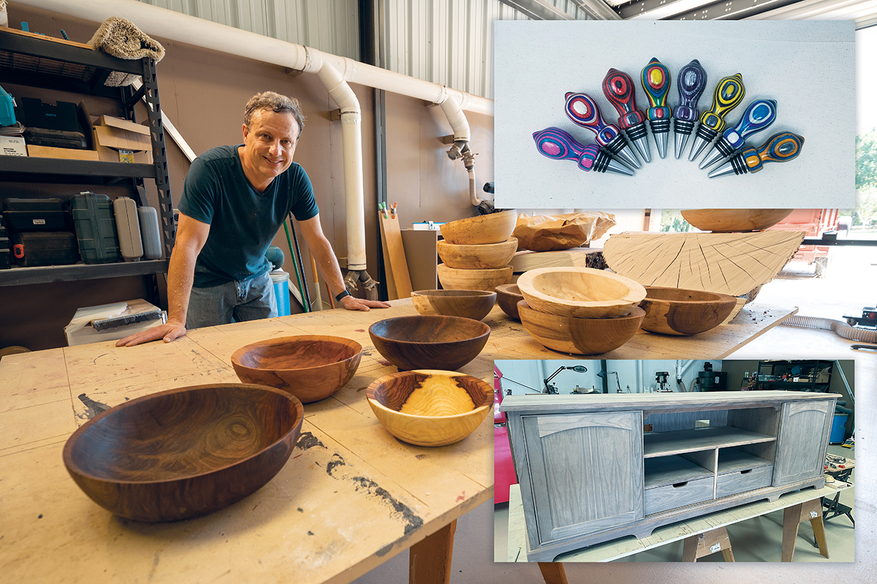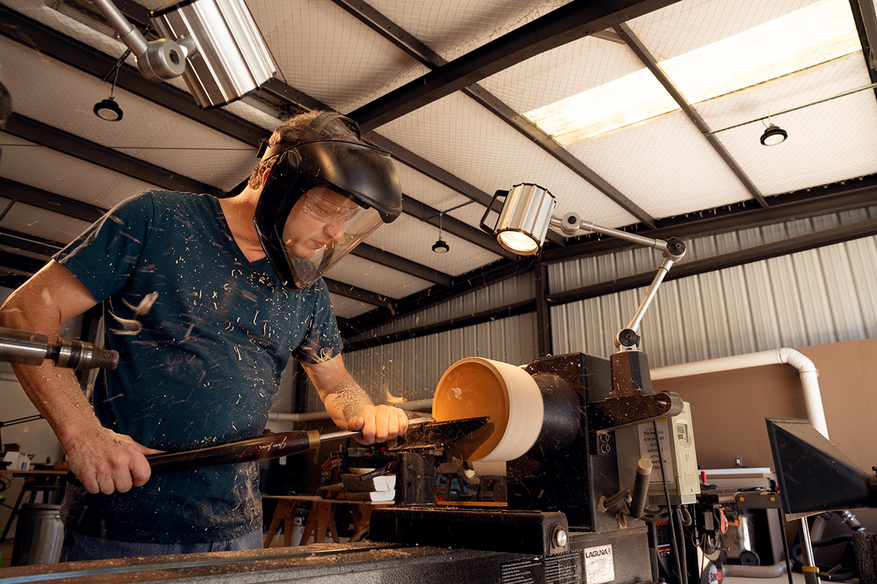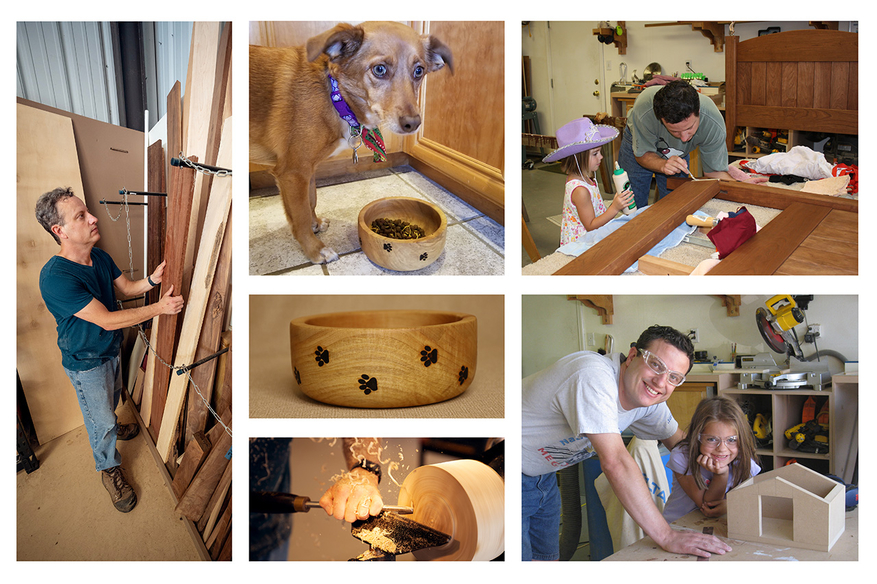As a child growing up in Livermore, John Fisher would accompany his father Dennis to the garage, where the woodworking tools were kept. Amid the sawdust, drills and tins of wood varnish, the younger Fisher absorbed knowledge of the craft while helping his dad glue together cabinets and other projects. The experience sparked an interest in woodworking that would remain steady over the years. When Fisher moved into his own condo, he set up a small shop where he refinished furniture.
In 1999, Fisher moved his family to a house with a three-car garage in Tracy, giving him more room to expand his burgeoning hobby. Poring through woodworking magazines, he fashioned speaker cabinets, made his daughters, Anna and Sadie, their own beds and writing desks and built other furniture for their home. With the help of YouTube videos, he taught himself the art of woodturning, using a lathe to shape salt and pepper grinders, wine stoppers and larger salad bowls, using green wood from fallen trees.
“I like woodworking because it’s different from my day job,” Fisher said. “At work, I write computer code, do IT (Information Technology) system administration and lead workforce management — none of that is physical or tactile. I like the contrast of working with something where you make cuts and shape something into a physical object. That’s very enjoyable, making something out of nothing.”
Fisher started off making his custom homemade wine stoppers as “a lark,” something to practice while learning how to use the lathe. He posted his first one on Facebook and immediately drew attention from family members.
“My cousin responded and said, ‘Will you sell me some of those?’” Fisher explained. “Then I thought, ‘maybe I’m onto a good thing.’”
In 2018, Fisher started his own Etsy site. The wine stoppers sold well and Fisher added salad bowls, which became quite popular. With help from his wife Cathy, he began plying his wares at craft shows, the Tracy farmers market, at churches and local festivals. He expanded into dog-food bowls, purchasing a soldering iron with a dog pawprint and burning the prints into the wood after shaping the bowls.
“The dog bowl was just sort of an invention of mine,” he said. “I don’t know how I got inspired to do it. It was just something I tried out and it actually ended up selling pretty well.”
To date, Fisher figured he’s made about 200 wine stoppers, his biggest seller a purple and silver edition.
“It’s relaxing and therapeutic to make a new one,” Fisher said. “I can go out there and while I do have to do some thinking about it, I’ve got my headphones on — usually Bruce Springsteen music — and I can just build something. It’s not overly stressful. Making large furniture pieces is fun as well, but it can be a stressful process when you make mistakes.”
In his day job as the Lab’s Information Technology Operations division leader and a DevOps team lead for the National Ignition Facility, Fisher enjoys the challenge of streamlining workflows and finding efficiencies. It’s a skill he carries over to his craft.
“To me, a lot of fun is refining a process,” Fisher said. “Even in my work life, I’m always interested in workflows and ways we can work and collaborate better. I’ve gotten the wine-stopper shaping and finishing down to 30 minutes. I have a specific shape I do that’s very repeatable. I use specific colors and different wood patterns for variety. That process refinement was fun and it’s been fun selling them.”
Fisher said while his father will spend three months working on one artistic bowl, Fisher’s bowls are more utilitarian; he can produce several a month. And he’s teaching what he’s learned to the broader woodworking community. He started his own YouTube channel where he’s posted videos demonstrating the basics of how to turn a newly fallen tree into a bowl. Each project starts with freshly cut pieces, which he usually sources from an arborist friend. His favorite wood to work with is walnut for its interesting patterns and colorations. Maple and purpleheart are close seconds.
“It’s a discovery process with each piece of wood,” Fisher said. “You start off with a fallen tree and then you get to that point where you’ve got this colorful, uniquely shaped salad bowl. Finding the nature’s design in that is really fun.”
Woodturning, he said, is a “bit of a guessing game. It can be difficult to tell whether the finished product will be good or not from the log or even the first cuts into it.
“You need to rough turn the bowl to really get a feeling for what the grain pattern or the colors are going to be,” Fisher said. “The reason some bowls end up not making it through the full lifespan is that you do a rough turn and then you leave them for six months and they crack or warp so badly that they’re not usable, so I have to throw some away.”
Zen and the art of woodworking
In late 2019, three months before the start of the COVID-19 pandemic, Fisher moved his family into a larger home in Tracy. He overhauled an auto shop out in the backyard that the previous owner had built, turning it into a 2,400 square-foot woodshop complete with two table saws, a bandsaw, lathe, router, planer, joiner and three sanders, as well as wood storage and a dust-collection system with hookups to the shop’s myriad of power tools.
“It’s big enough that I’ve got room to keep multiple projects going concurrently. It’s nice to have these big tables available to keep my efforts separate and organized,” Fisher said.
More complex projects have typically started with a plan pulled from a woodworking magazine, except for his recently built media center in an upstairs movie theater, which he customized in his own unique style. His favorite projects were building beds and dressers for his daughters. For one of the dressers, he heavily modified the magazine plans so it matched the styling of the bed.
“That wasn’t the plan that I started with,” Fisher said. “It was nice to be able to have a project that started with a baseline, where somebody’s already measured out the specs for you, but then I was able to do a lot of innovations and add some creativity within that as well.”
On the other hand, building furniture is “a lot more engineering and less creative” than woodturning, Fisher said. Furniture projects generally start with large sheets of wood; and since a sheet of plywood can cost more than $120, there’s more emphasis on which cuts need to be done to use the wood efficiently, so none of it goes to waste.
“They’re not kidding when they say, ‘measure twice, cut once,’” Fisher said. “There’s a lot of engineering and planning ahead required. You need to closely read directions because if you do things in the wrong order, you can really put yourself in a bind.”
Each project has been a learning experience. One particularly challenging project, a rolling tool cart with drawers, was “a bit beyond my capabilities at the time,” Fisher admitted. He got halfway through and set it aside for more than a year, before going back with greater expertise and some new approaches. He was eventually able to finish it and still has it in his shop today.
“Hard maple is challenging to work with and I didn’t have the tools to really do it properly,” Fisher recalled. “When I cut the wood, it would burn my table saw blade and cause my power breaker to pop. When I’d put in a large bolt, I’d break the bolt off, despite a sizable pilot hole. I had to learn some new techniques to end up with the results that I wanted.”
Fisher wanted to give up on the project several times and throw it away, but persevered and was proud of the final product. Besides persistence, Fisher said novice woodworkers should learn to cultivate patience and know when to stay out of the shop.
“If you’ve had a bad day and you’re carrying that inside of you, you might find yourself starting to make mistakes or rush things,” Fisher said. “I would get myself in trouble [in the past] and screw up something big. Some of the projects are complicated and there are times where you just need to step back and say, ‘probably not a good day to be in the shop right now.’ You don’t want to waste the wood and ruin the project.”
Fisher (knock on wood) has never suffered a serious injury while using a table saw or other power tool. Safety is a trait he also might have picked up from his father, a former associate director for Safety, Security and Environmental Protection and associate director for Engineering. Dennis Fisher is turning 80 this year, but still enjoys working in the detached wood shop that he built from scratch at his Livermore home. It’s not uncommon for him to offer his son tips and advice on places he might be stuck on in his latest projects.
Fisher said he’s unsure what the next phase of his woodworking hobby will look like, but he’d like to continue to make more salad bowls, which have become hot items. A father–daughter project with Sadie, a desktop clock, is half finished and Fisher hopes they can complete it soon. One day, he would like to tackle his dream project: a grandfather clock.
“It’s a big challenging project that would be neat to add to the house, so I’m always looking for plans for that,” Fisher said. “I don’t think I could do the ones that have all this ornamentation and are really extravagant, but doing something elegant and attractive would be fun.”
– by Jeremy Thomas







